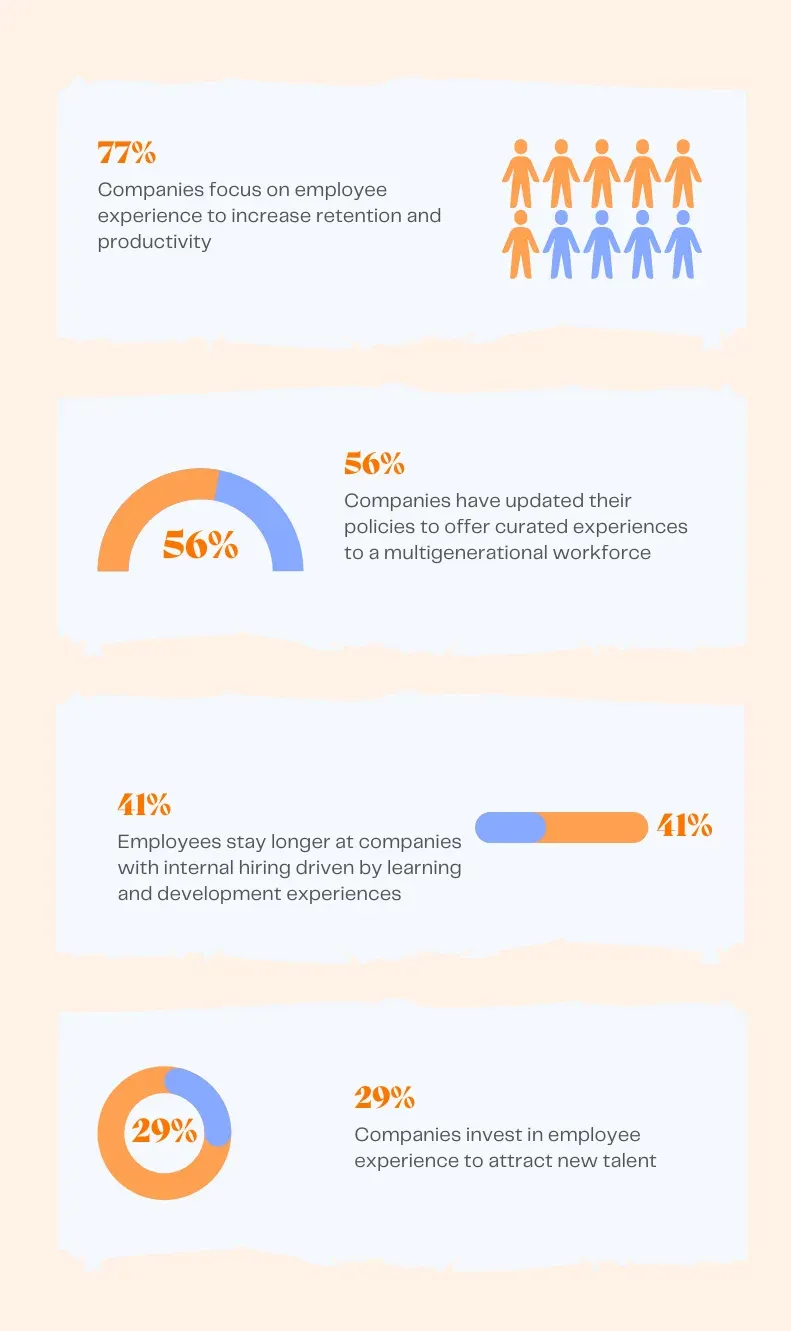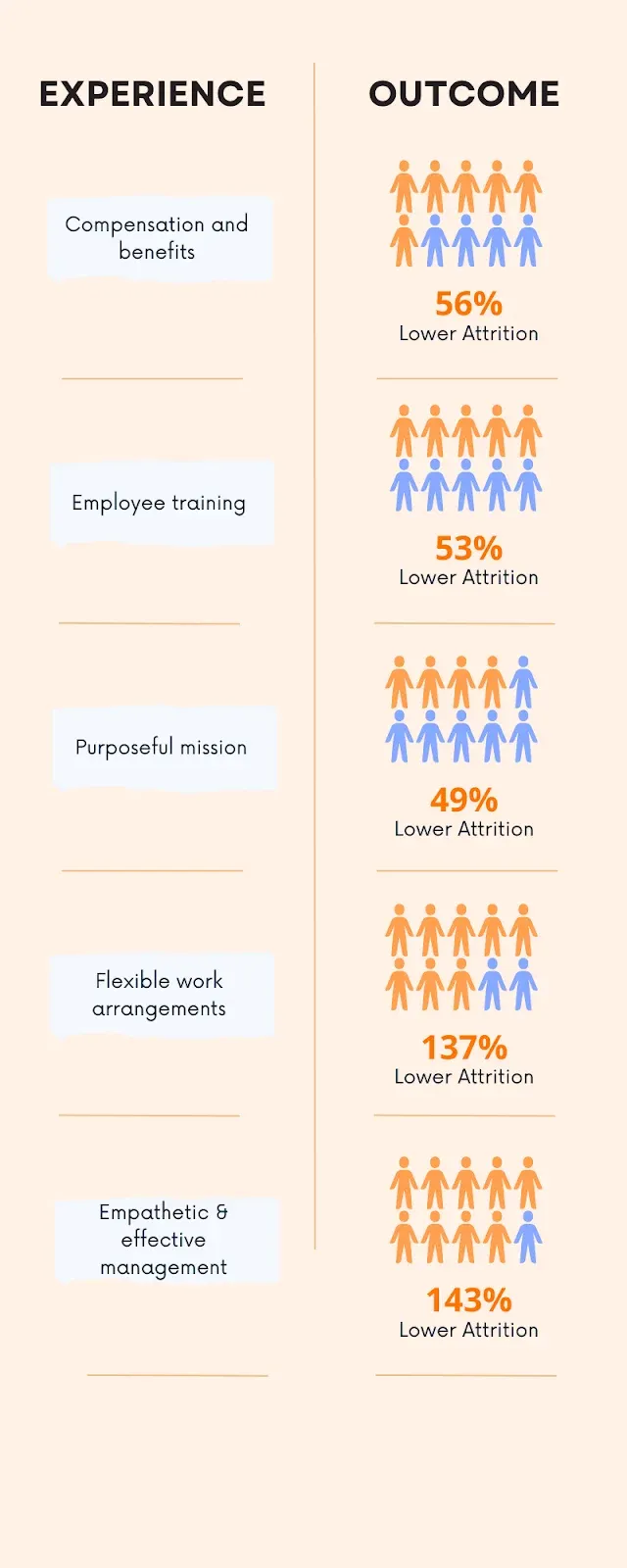Mengapa Pengalaman Pekerja Penting dan Apakah Hasilnya
Pengalaman pekerja bukan sekadar kata kunci atau istilah pemasaran. Ia adalah kunci kejayaan anda. Berikut adalah 10 sebab mengapa pengalaman pekerja penting.
Pada halaman ini
- Employee experience is a business imperative
- The employee experience shouldn’t be like buying car insurance
- Why is employee experience important
- How to prioritize employee experience
- Outcomes of positive employee experience
- Leveraging Empuls to elevate employee experience for a thriving workplace
- Ke arah masa depan yang berpusatkan pekerja
In recent years, we have seen many companies invest heavily in one of their most vital assets—their employees. From free lunches to Fun Fridays, relaxed workspaces, standing desks, or yoga/meditation rooms, there’s been a slew of initiatives aimed at enthusing employees and accelerating productivity. However, why is employee experience important beyond just perks?
Tetapi inilah tangkapan: kebanyakan syarikat ini memberi tumpuan kepada faedah dan faedah. Hanya segelintir organisasi yang mengutamakan pengalaman pekerja untuk mewujudkan hubungan yang lebih kuat dan bermakna dengan tenaga kerja mereka. Ini bukan kerana kurang mencuba.
The 2020 HR Sentiment Survey proves that employee experience is currently ranking as one of the top initiatives for business leaders (50% responders).
The problem lies in comprehending the importance of the employee experience and accurately mapping it to positive business outcomes. In most cases, employers are employees who are misaligned on what drives good experiences.
Employee experience is a business imperative
The shift in power from organizations to individuals has led to more and more businesses focusing on improving the journey their employees take with them – a journey called the employee experience.
Sebagai KPI baru untuk mengukur pengekalan, produktiviti, dan prestasi keseluruhan, pengalaman pekerja memacu pertumbuhan perniagaan dan pemerolehan pelanggan baru. Anda tidak boleh memandang rendah nilainya!

Mari kita jadikannya sedikit lebih berkaitan dengan menggunakan analogi membeli insurans kereta.
The employee experience shouldn’t be like buying car insurance
Mari tanya soalan mudah-apakah persamaan antara pengalaman pekerja dan membeli insurans kereta?
Membeli kereta baru dilengkapi dengan tanggungjawab tambahan untuk membeli insurans kereta yang baik. Walau bagaimanapun, proses membeli seseorang boleh menyebabkan anda tertekan dan terharu.
Di suatu tempat antara menentang padang jualan yang terlalu banyak, membandingkan beratus-ratus polisi, mencari yang dengan harga yang betul (yang tidak membakar lubang di dalam poket anda), membaca cetakan halus (jangan langkau!), dan menyelesaikan kertas kerja yang tidak berkesudahan, pembeli dibiarkan mengalir dari pengalaman membeli insurans dan mempunyai sedikit semangat yang tersisa untuk menikmati keretanya yang baru diinsuranskan.
Begitu juga, persekitaran kerja yang tidak menyokong, teknologi yang mencabar, tekanan kerja yang semakin meningkat, dan hubungan yang tegang di pejabat boleh menyebabkan pekerja anda merasa letih dan tidak berminat dalam kerja mereka.
Untuk mengatasi masalah ini, anda mesti memberikan pekerja anda pengalaman yang menjadikan mereka komited secara emosi terhadap kerja mereka dan merasa dihargai. Layan mereka dengan empati, dan mereka akan menjadi penyokong jenama terkuat syarikat anda.
Forbes mengesyorkan gabungan elemen fizikal (tempat kerja), sosial (hubungan), dan teknologi (alat dan proses) untuk mewujudkan pengalaman pekerja yang positif. Ia melibatkan pelbagai pihak berkepentingan yang sejajar ke arah mewujudkan tempat kerja holistik yang berpusat di sekitar pekerja sebagai inisiatif perniagaan.

Why is employee experience important
Ringkasnya, pengalaman pekerja adalah tentang mengutamakan orang. Pekerja adalah tulang belakang perniagaan, dan tindakan mereka boleh menentukan kenaikan atau kejatuhan sesebuah organisasi.
Jenis hubungan mereka dengan majikan, jumlah usaha yang akan mereka dedikasikan untuk mengembangkan perniagaan, dan perkhidmatan yang akan mereka berikan kepada pelanggan ditentukan oleh bagaimana syarikat mengutamakan keperluan pekerja (jika sama sekali).
1. Talent attraction and retention
A positive work environment attracts top talent and keeps employees engaged, reducing turnover rates. Job seekers evaluate companies based on culture, growth opportunities, and overall experience.
When employees feel valued and supported, they are more likely to stay, lowering recruitment and training costs. The importance of employee experience in retaining skilled professionals cannot be overlooked.
2. Revenue growth and shareholder returns
A well-designed EX strategy drives business success by improving productivity, enhancing customer interactions, and reducing operational inefficiencies.
Engaged employees are more motivated to contribute, leading to higher revenue and improved shareholder value. Businesses that invest in EX often see a direct impact on profitability and long-term sustainability.
3. Cohesion and collaboration
A workplace built on trust and support fosters stronger teamwork. When employees feel heard and appreciated, they collaborate more effectively, breaking down silos and driving better results. Creating an environment that encourages open communication and teamwork strengthens both employee relationships and overall business efficiency.
4. Enablement and empowerment
Giving employees access to the right tools, resources, and training enables them to perform at their best. When employees feel empowered to take initiative and make decisions, they are more confident and engaged in their roles. Organizations that prioritize EX create a culture of trust and ownership, leading to higher performance and job satisfaction.
5. Engagement and work commitment
Disengaged employees are costly—they lead to higher absenteeism, reduced productivity, and a negative work culture. The importance of employee experience lies in its ability to foster commitment and motivation.
When employees feel connected to their work, their engagement levels rise, resulting in better performance and a stronger alignment with company goals. Organizations that prioritize EX see greater job loyalty and increased discretionary effort from their workforce.
6. Creativity and Innovation
Innovation thrives in an environment where employees feel secure, encouraged, and inspired. A workplace that prioritizes well-being and professional development allows employees to think creatively and explore new ideas.
When employees feel supported, they take calculated risks, experiment, and contribute innovative solutions that drive business growth.
7. Brand advocacy
Satisfied employees naturally become ambassadors for the company, sharing their positive experiences with potential hires, customers, and industry peers. A strong EX enhances employer branding, improves reputation, and helps attract high-quality talent. Employees who believe in the company’s mission and values create a ripple effect that strengthens external brand perception.
The importance of employee experience extends beyond HR—it influences company culture, profitability, and overall growth. Prioritising EX results in a more engaged workforce, improved collaboration, and a stronger business foundation. Why employee experience matters is clear: when employees thrive, businesses flourish.
How to prioritize employee experience
Walaupun faedah yang paling biasa melabur dalam pengalaman pekerja termasuk kepuasan pelanggan dan produktiviti, terdapat beberapa sebab lain mengapa ia penting dan bagaimana untuk mengutamakannya.
Berikut ialah peraturan praktikal yang mudah untuk dilalui—jika pekerja anda muncul untuk bekerja dan pergi dalam suasana hati yang baik, jika mereka berdedikasi untuk kerja dan pelanggan mereka jika terdapat geseran minimum dalam dan di seluruh pasukan—maka anda berada di jalan yang betul untuk strategi pengalaman pekerja transformatif.
Outcomes of positive employee experience
Laporan LinkedIn baru-baru ini menunjukkan kesan perniagaan strategi pengalaman pekerja yang baik:

Multiple studies conducted by Forbes, Gartner, and Gallup show that while some organizations are still catching up to the trend of appreciating and motivating their employees, others, realizing the value of high-ROI employee experience, are steadily making it to the top of the Best Employer lists, reaping rich rewards.
Leveraging Empuls to elevate employee experience for a thriving workplace

A great employee experience boosts engagement, productivity, and retention. Employees who feel valued and connected are more committed to their work, leading to stronger morale and lower turnover.
This is where Empuls makes a difference. By integrating recognition, rewards, feedback, and collaboration, Empuls helps businesses create a culture where employees thrive.
✅ Meaningful recognition: Celebrate achievements with personalized rewards and peer appreciation.
✅ Real-time employee feedback: Gather insights through surveys to address concerns proactively.
✅ Stronger team connections: Foster engagement with a social intranet for seamless communication.
✅ Personalized incentives: Offer wellness perks, tax-free benefits, and exclusive discounts.
✅ Automated engagement: Keep employees motivated with structured recognition programs.
Employee experience drives success. With Empuls, organizations can build a workplace where employees feel valued, supported, and inspired.
Create a workplace where employees feel valued, engaged, and motivated. Empuls helps you drive recognition, rewards, and meaningful connections—all in one platform.
Ke arah masa depan yang berpusatkan pekerja
Untuk beroperasi dalam persekitaran perniagaan yang moden dan kompetitif berdasarkan ekuiti jenama, pertumbuhan mampan, pengekalan bakat, dan produktiviti, syarikat mesti memupuk pemahaman yang lebih mendalam tentang pekerja mereka sambil terus meningkatkan pengalaman mereka berdasarkan maklum balas yang kerap.
Laluan ke hadapan terletak pada membina rangka kerja pengalaman bersepadu di mana pekerja dilayan dengan empati, dihargai, dipupuk, dan ditanamkan dengan tujuan semasa bekerja dalam persekitaran yang inklusif dan mampan.
"EX bukan sekadar acara yang menyeronokkan. Ini membuat orang berasa selamat dan gembira sehingga mereka dapat melakukan yang terbaik." - Wassim Eid, CHRO, Chalhoub













